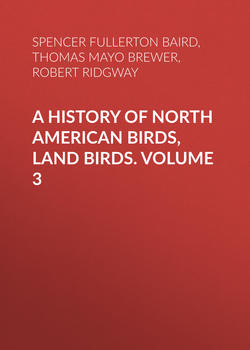Читать книгу A History of North American Birds, Land Birds. Volume 3 - Robert Ridgway - Страница 2
Family STRIGIDÆ.—The Owls
ОглавлениеChar. Eyes directed forward, and surrounded by a radiating system of feathers, which is bounded, except anteriorly, by a ruff of stiff, compactly webbed, differently formed, and somewhat recurved feathers; loral feathers antrorse, long, and dense. Plumage very soft and lax, of a fine downy texture, the feathers destitute of an after-shaft. Oil-gland without the usual circlet of feathers. Outer webs of the quills with the points of the fibres recurved. Feathers on the sides of the forehead frequently elongated into ear-like tufts; tarsus usually, and toes frequently, densely feathered. Ear-opening very large, sometimes covered by a lappet. Œsophagus destitute of a dilated crop; cœca large. Maxillo-palatines thick and spongy, and encroaching upon the intervening valley; basipterygoid processes always present. Outer toe reversible; posterior toe only about half as long as the outer. Posterior margin of the sternum doubly indented; clavicle weak and nearly cylindrical, about equal in length to the sternum. Anterior process of the coracoid projected forward so as to meet the clavicle, beneath the basal process of the scapula. Eggs variable in shape, usually nearly spherical, always immaculate, pure white.
The Owls constitute a very natural and sharply limited family, and though the species vary almost infinitely in the details of their structure, they all seem to fall within the limits of a single subfamily.
They have never yet been satisfactorily classified, and all the arrangements which have been either proposed or adopted are refuted by the facts developed upon a close study into the true relationship of the many genera. The divisions of “Night Owls,” “Day Owls,” “Horned Owls,” etc., are purely artificial. This family is much more homogeneous than that of the Falconidæ, since none of the many genera which I have examined seem to depart in their structure from the model of a single subfamily, though a few of them are somewhat aberrant as regards peculiarities in the detail of external form, or, less often, to a slight extent, in their osteological characters, though I have examined critically only the American and European species; and there may be some Asiatic, African, or Australian genera which depart so far from the normal standard of structure as to necessitate a modification of this view. In the structure of the sternum there is scarcely the least noticeable deviation in any genus7 from the typical form. The appreciable differences appear to be only of generic value, such as a different proportionate length of the coracoid bones and the sternum, and width of the sternum in proportion to its length, or the height of its keel. The crania present a greater range of variation, and, if closely studied, may afford a clew to a more natural arrangement than the one which is here presented. The chief differences in the skulls of different genera consist in the degree of pneumaticity of the bones, in the form of the auricular bones, the comparative length and breadth of the palatines, and very great contrasts in the contour. As a rule, we find that those skulls which have the greatest pneumaticity (e.g. Strix and Otus) are most depressed anteriorly, have the orbital septum thicker, the palatines longer and narrower, and a deeper longitudinal median valley on the superior surface, and vice versa.
The following classification is based chiefly upon external characters; but these are in most instances known to be accompanied by osteological peculiarities, which point to nearly the same arrangement. It is intended merely as an artificial table of the North American genera, and may be subjected to considerable modification in its plan if exotic genera are introduced.8
7
I have, however, examined the sterna only of Nyctea, Bubo, Otus, Brachyotus, Syrnium, Nyctale, and Glaucidium.
8
My unpublished determinations of the North American species were furnished, by request, to Dr. Coues, for introduction into his “Key of North American Birds”; consequently the names used in these pages are essentially the same as those there employed.
